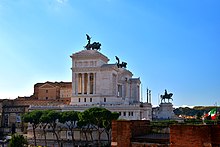Monumento a Vittorio Emanuele II
The Monumento Nazionale a Vittorio Emanuele II ( National Monument to Victor Emanuel II ), usually Vittoriano or Altare della Patria (Altar of the Fatherland), is a national monument in Rome completed in 1927 . It is located on the Capitol Hill at the southern end of Via del Corso between Piazza Venezia and the Roman Forum , next to the Forum of Trajan .
The monument is dedicated to the first king of the newly established Kingdom of Italy , Victor Emmanuel II of the House of Savoy . Today it is one of the state symbols of the Italian Republic . The building houses the Museo del Risorgimento , which is reminiscent of the Italian founding movement in the 19th century.
history
On the occasion of the death of King Vittorio Emanuele II in 1878, it was decided to erect the monument. It was built from 1885 by Giuseppe Sacconi . In 1911 the inauguration of the still unfinished monument took place on the occasion of the 50th anniversary of the unification of Italy at the same time as the 50th anniversary of Italian unity. It was not completed until 1927. The monument reflects the neoclassical atmosphere of that time, which manifests itself in the massive marble stairs , a twelve meter high bronze equestrian statue of the king and a monumental row of columns at the top. This portico is painted with an ornamental frieze made of tempera , which can be seen on the night photograph. The gigantic structure is positioned across from the basilica of Santa Maria in Aracoeli , which is not small at 80 meters in length , and which, in keeping with the founding intention, can no longer be seen from both Piazza Venezia and Piazza della Repubblica is. The Romans jokingly called it “Macchina da scrivere” (“typewriter”).
On December 12, 1969, at half past five in the afternoon, an attack was carried out on the memorial with two bombs detonated ten minutes apart. At the same time, the bomb attack on Piazza Fontana took place in Milan . Nobody was injured by the attack, but the Vittoriano remained closed to the public for the following decades. It was not until September 24, 2000, due to an initiative of the then President of the Republic of Italy, Carlo Azeglio Ciampi , that public traffic was permitted again.
As usual with many national monuments, there is a tomb of the unknown soldier and the "Altar of the Fatherland " (Italian Altare della Patria ) on the Vittoriano. The eternal flame is guarded day and night by two soldiers. From there the view extends over the Roman Forum, the imperial forums in the southeast and far over the city of Rome.
architecture

The architecture of Vittoriano is determined by a monumental Corinthian portico, which is closed on its sides with Corinthian pronai . The rhythm of the pillars lends the massive and very complex building simplicity. In the context of urban development, due to its size, it develops a structural dynamic that results from the reference of the building to the street axes intersecting in Piazza Venezia and from the contrast to the lower, surrounding architecture.
Sacconi's architecture refers to ancient monuments such as the Pergamon Altar and the sanctuary of Fortuna Primigenia in Palestrina . Accordingly, the monument is designed as a large neoclassical forum. Its terraces spread over several levels and the presence of an architecture rich in classic set pieces create a symbolic frame of reference for the still young Italy in the midst of the ruins of ancient Rome.
At the time of its inauguration in 1911, in the backlight of some foreign pavilions at the World Exhibition in Turin, such as the Josef Hoffmanns for Austria, it shows how closely the architecture at that time is still connected to the academic tradition of historicism and eclecticism .
The equestrian statue of the king is the work of the sculptor Enrico Chiaradia . There is a quadriga on top of the Vittoriano .
Museums
Inside the building is the Museo del Risorgimento , with the entrance on Via di San Pietro in Carcere , which houses a permanent exhibition on the Italian Wars of Independence . The troop flags of disbanded Italian military units and the ships' flags of decommissioned warships are exhibited here ( Sacrario delle Bandiere ). There is also a small marine history collection on display.
The National Museum of Italian Emigration ( Museo Nazionale dell'Emigrazione Italiana ) opened in September 2009 . It shows the Italian emigration from the end of the 19th century to the present.
literature
- Thorsten Rodiek : The Monumento nazionale Vittorio Emanuele II in Rome. (European university publications series 28 art history volume 30), P. Lang, Frankfurt / Main - New York - Paris 1983. Zugl .: Stuttgart, Univ., Diss., 1981 ISBN 3-8204-5418-7
Web links
Individual evidence
- ↑ Chiaradia, Enrico Aldo Rizzi in Dictionnaire Biografico degli Italiani , Volume 24, 1980
- ^ Opening of the National Museum of Italian Emigration . Italian Ministry of Foreign Affairs, October 23, 2009, accessed November 8, 2019.
Coordinates: 41 ° 53 ′ 41 ″ N , 12 ° 28 ′ 58 ″ E



